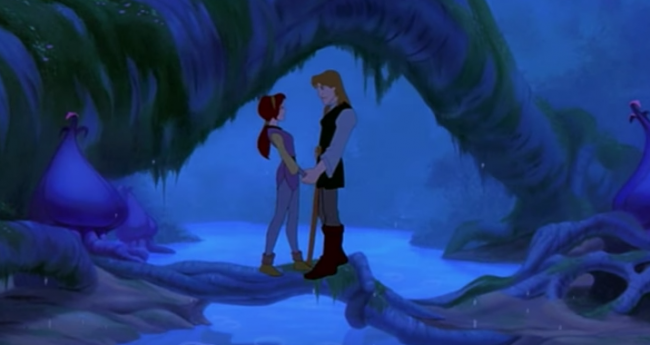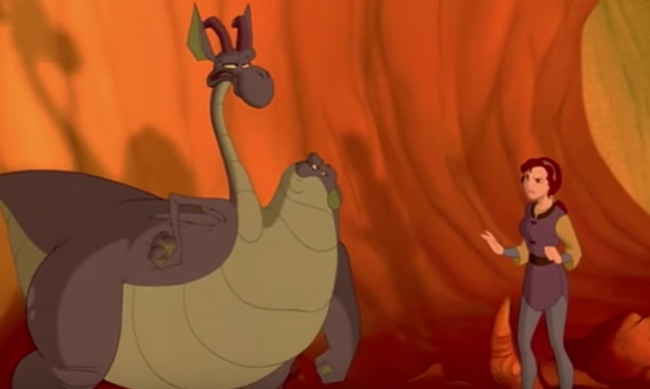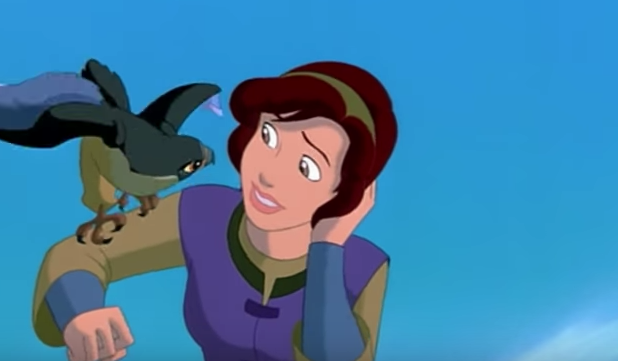Rewind Regrets: The Magic Sword: Quest For Camelot (1998)
Nostalgia can't hold together this animated misfire.

The Magic Sword: Quest for Camelot is a 1998 animated musical about a brave girl, a blind hermit, and an awkward two-headed dragon who try to find the lost sword Excalibur and save Camelot.
There’s a reason Disney holds a monopoly on quality animated entertainment, even if some of their films might not all be masterpieces. For one thing, it’s what they do, with teams dedicated to the art of it, staffs working in departments that strive to combine stories and images, aiming for the highest standards. For decades upon decades, they’ve established a powerful infrastructure that is committed solely to the production of these kinds of movies.
In 1998, Warner Bros did not. Setting up shop in 1992 and releasing its first film in 1993, Warner Bros. Family Entertainment was a division created to provide projects meant for children, with content focused on television programming and movies, both live-action and animated. Under the banner, early works included Free Willy, The Secret Garden, and the animated Batman: Mask of the Phantasm, the latter a box office failure despite the cult following it gained on home video.
It didn’t get much better. The following year was the company’s worst, with a string of animated bombs that met with audience and critical dismissal, forcing the studio to switch back to low budget, live-action family titles, though another animated movie called The Pebble and the Penguin was a complete box office disaster. While the next year found success in the Looney Tunes big screen film Space Jam, and a year later with the sequel to Free Willy, their trend of poorly-received animated movies continued unabated.
Such was the case in 1998 with the release of The Magic Sword: Quest for Camelot, or simply Quest for Camelot in North America, another variation on the often told legend of King Arthur, though this one centers on a peripheral story. Like most other animated movies by the studio, it was a flop, earning less than its budget, despite an all-star cast, including Pierce Brosnan, Gabriel Byrne, Jane Seymour, and John Gielgud, yet memories seemed to think it was better. Watching again, that proved wrong.

The story follows a girl named Kayley (voiced by Jessalyn Gilsig), the daughter of a Knight of the Round Table, who herself wants to grow up and be like her father. When a knight named Baron Ruber (Gary Oldman), longing for the “good old bad days” of danger and adventure, makes a move to be king rather than Arthur, Kayley’s father is killed in the fight.
Ruber flees, but ten years later, his massive griffin attacks Camelot and steals the legendary sword of power, Excalibur, but loses it in a fight with Merlin’s falcon, the weapon falling into the Forbidden Forest. Meanwhile, Ruber invades Kayley’s home and while she escapes, he uses a vile potion given to him by witches to turn his army into hybrids of man and metal, weaponizing them into brutish war thugs, including a chicken crossed with a hatchet. Admittedly, that’s funny.

Determined to find Excalibur and save Camelot, she heads into the forest but stumbles into a trap and instead meets Garrett (Cary Elwes), a young blind hermit who used to be a stable boy in royal city. He prefers to work alone, singing that he stands alone, but you know … girls. He changes his mind. Eventually, together, along with Merlin’s falcon, and later a bumbling two-headed dragon, they scour the woods in a story filled with songs, romance, and adventure, as they quest for Camelot. Sort of.
Directed by Frederik Du Chau, a Belgian filmmaker with only four credits to his name since 1987, Quest for Camelot is a mediocre film at best, poorly animated and presented with unmemorable songs and a predictable script that is tragically formulaic and underwhelming. While nearly twenty years ago, it was never a hit, there was, over time, a sense of nostalgia to it that had painted it in fairer colors, but watching it again now, fails on nearly every level.
The most problematic issue, at least visually, is the stiff animation and poorly-drawn characters, all of whom are bland and oddly irregular. The two-headed dragon, named Devon and Cornwall, voiced by Eric Idle and Don Rickles comes of best in all respects and delivers probably the best message for the intended audience as well, learning that by working together–something they fought against throughout–allows them to be a true dragon. They also get a few funny lines.

The movie is almost entirely hand-drawn though a few moments are a mix of that and low-grade CGI, including a giant cave ogre who at one point, I kid you not, farts so big it sends Ruber and his griffin flying into a wall after they get stuck under its butt. While the weak plot device is one thing, the animation is the the other, with dull use of both, and when you consider that it had a 10 million dollar budget larger than Pixar had for Toy Story, a film that was released three years earlier, the lack of quality becomes curious.
If there is a positive in the story, it is Garrett, who is blind, but never made to define him as such, and never viewed as a weakness, though to a degree, there is a calculation in all that, but at least is a solid message. The plunky Kayley however is a textbook girl-out-to-prove-herself cliché that feels threadbare from an over-saturation of the character type, even at the time.

Perhaps most disappointing are the songs, most of which are unmemorable, despite some real talent behind the music including Steve Perry, LeAnn Rimes, and Celine Dion, whose version of one song, The Prayer, went on to win a Golden Globe and earn an Academy Award nomination. The score was composed by Patrick Doyle, who has done great work before and after, but here at least satisfies the needs, giving some of the high energy moments some momentum.

One cool aspect is not the film itself but the movie’s amazing theatrical poster, created by the late John Alvin, who was behind such classic one-sheets as E.T. the Extra-Terrestrial, The Goonies, The Little Mermaid, and Blade Runner to name a few (read more about Jon Alvin and the Blade Runner poster). It’s a great illustration and capture’s the film’s adventurous potential.
Quest for Camelot suffered from some studio shake ups at the time and a short production schedule that had the film in turmoil before it was ever released, which is too bad because the premise at least had some clever ideas. While children still might get something out of it, looking back now, it is one best left to memories.
